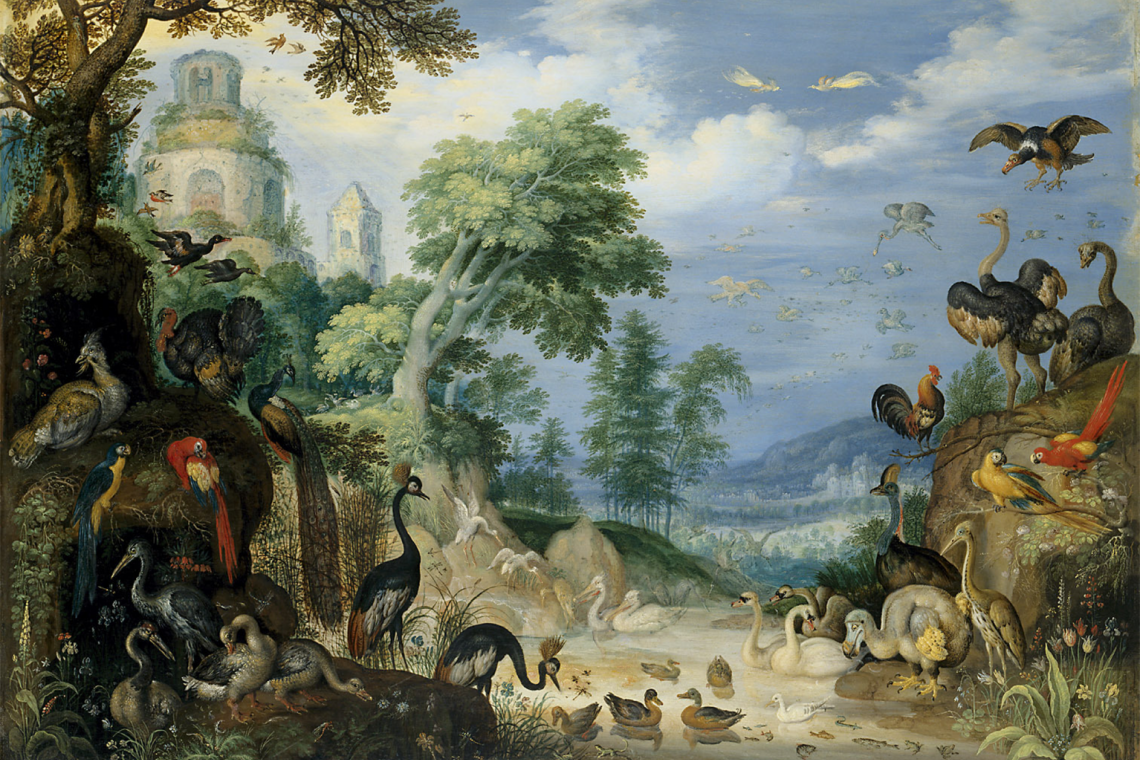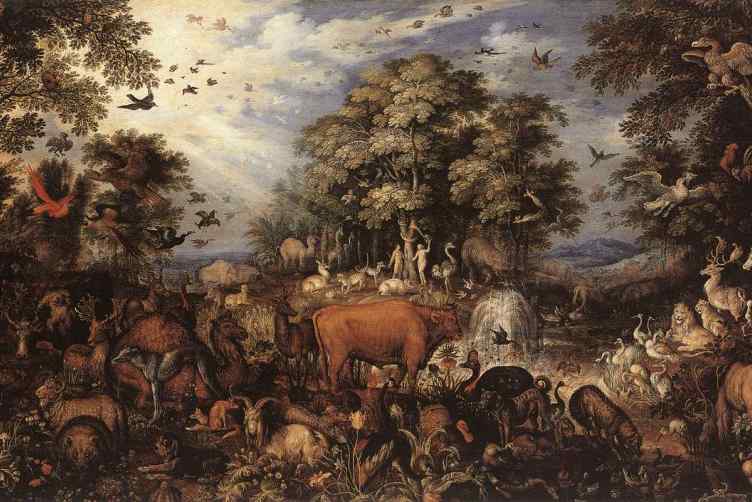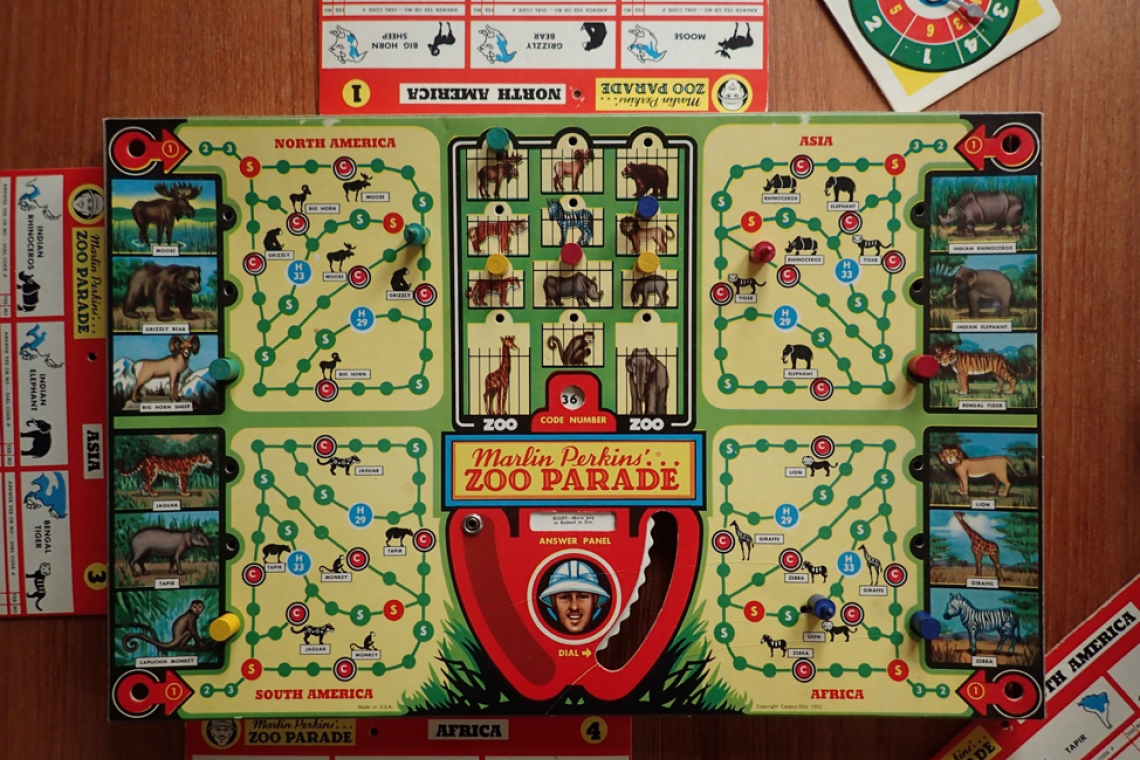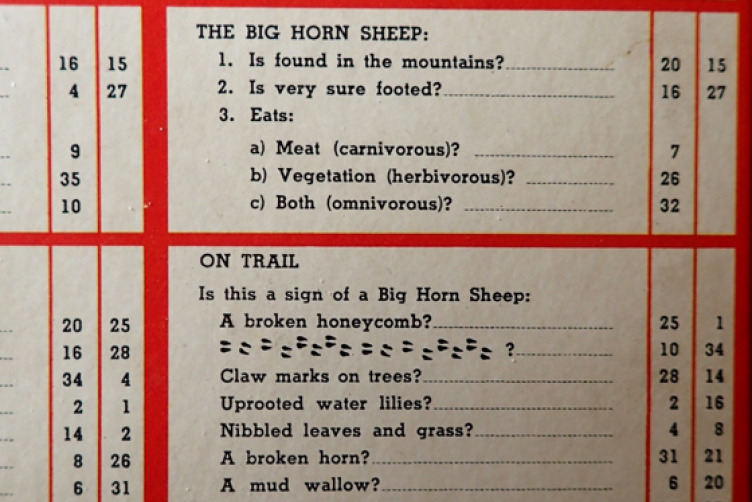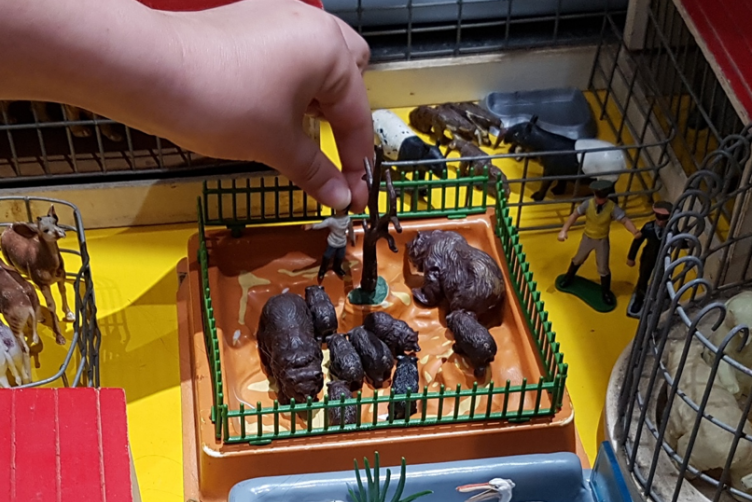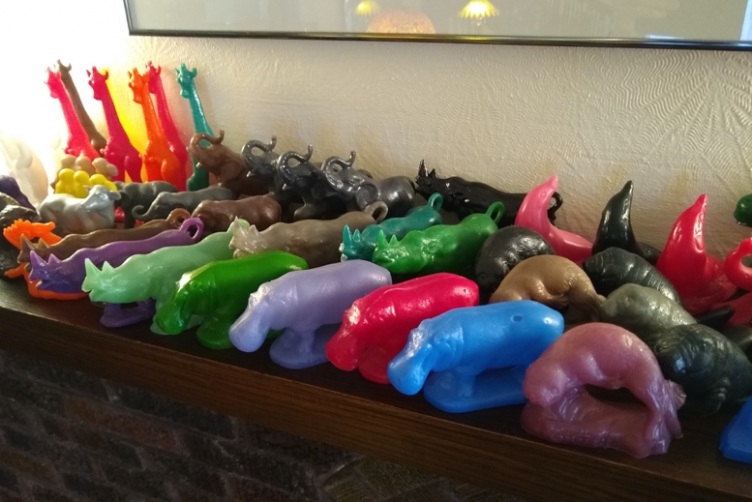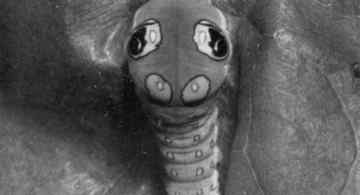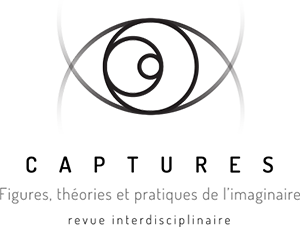Of Dodos and Menageries
It is an improbable scene: a central European landscape of castle ruins, oaks, and pines with a view from a small pond surrounded by birds from all over the world1. There are two black crowned cranes, an American turkey, mute swans, graylag geese, grey herons, storks, pelicans, a cinerous vulture, a male and female ostrich, two blue and gold and two scarlet (or perhaps now-extinct lesser Antillean) macaws, a spoonbill, a cockerel, a roosting peacock and hen and two white peacocks flying, song birds, what might be a glaucous gull, various ducks, dragonflies, lizards, frogs, fish, and flowers (including yellow lupine and tulips), a cassowary and, finally, a dodo. On a rock in the center middle, surmounted by a lizard and a grasshopper, the artist Roelandt Savery has placed his name and the date, 1628. While Savery’s name may not be as well-known to visitors of the Kunsthistorisches Museum in Vienna where the relatively small painting resides, historians, ornithologists, and the curious have been repeatedly drawn to the Landscape with Birds because of the prominent illustration of a dodo looking seemingly pensively at a fish swimming in the shallow water. That dodo, along with the cassowary next to it, points to a specific moment in European and global history.
Savery’s Landscape was one of many paintings filled with animals by the Flemish artist. Typically setting his unusual menageries in mythical or biblical accounts of Orpheus, Noah, or Eden, Savery found an audience for works brimming with the kinds of exotic creatures that were arriving in Europe on ships traveling around the world in the 16th and 17th centuries, all presented side-by-side with the more familiar animals of Europe. A quick look at his The Paradise of 1626, with its almost collage-like character, makes clear that his animals had likely not always been personally observed. His elephants, rhinoceroses, and giraffes, for example, are unconvincing, as are his deer and lions. The scales are haphazard, too — a bear is smaller than a sheep, a bull towers over the cassowary — and why is there a 17th-century water feature in the Garden of Eden? Still Savery’s birds, butterflies, and flowers are often drawn with special care and sensitivity. With their repeated profiles and stances, some of these, too, were clearly studied from stuffed specimens, but others, especially his lively macaws, seem to have been based on living birds.
Many of the living animals were undoubtedly seen by Savery in private collections or the large menagerie belonging to the Holy Roman Emperor Rudolf II, for whom Savery worked from around 1604 to 1616 along with an assortment of other painters, writers, naturalists, alchemists, astronomers, and thinkers brought to the Bohemian court in Prague. It was there that he saw the probably-still-living first-known cassowary to arrive in Europe — a southern, double-wattled specimen obtained in the Banda Islands that landed in Amsterdam in 1597 and, after moving through several collections, arrived in Prague some years later (Rothschild, 1901: 115). Rudolf also had at least one dodo, a bird that began to become better known to Europeans at the end of the 16th century through published accounts of the voyage to Mauritius of Jacob Cornelis van Neck. Among the natural history items in Rudolf’s collections was an apparently stuffed dodo illustrated by Jacob Hoefnagel around 1602, and there may have been a living specimen in the menagerie, as well. In any case, after Savery moved to Utrecht in 1621, dodos, cassowaries, and other rarely seen creatures began to make regular appearances in his works (see, for example, Strickland and Melville, 1848; Hachisuka, 1953; and Hume, 2006).
In recent years, researchers have found more and more unusual animals walking and flying around medieval and early modern Europe. Heather Dalton’s discovery of a sulfur-crested cockatoo in Andrea Mantegna’s Madonna della Vittoria — a nine-foot-high painting commissioned by Francesco II Gonzaga for an altar in a small chapel in Mantua in 1497 — is only one of the better-known examples of historians discovering animals dislocated in place and time (Mead, 2021). The dodo that Savery saw and drew was one of these dislocated animals. Brought to Europe aboard an East Indian trading ship, the dodo probably didn’t survive long before it succumbed to stress, climate, the wrong foods, disease, or just neglect. This outcome, of course, has been echoed by literally millions of other creatures that have been captured for zoological collections of one kind or another2. Savery’s dodo — the inspiration over two-hundred years later for John Tenniel’s illustrations in Lewis Carroll’s 1865 Alice’s Adventures in Wonderland — was an actual bird, alive just decades before the species became extinct. Along with the last passenger pigeon and the last Carolina parakeet, both at the Cincinnati Zoo, the last thylacine at the Beaumaris Zoo, and many others, Savery’s dodo is one of the “last ofs” that have lived and died in the animal trade. Precisely because of the extinction of their kind, many of those animals remain remarkably well known even now, long after they died. It is hard to imagine that people would be as interested in Savery today were it not for the fact that he put some images of dodos into some of his paintings. Search the internet for “Savery dodo” and you’ll find plenty of articles written with amusement about an “ungainly” bird in his paintings. Savery’s fame, it seems, persists because dodos became extinct through the activities of Europeans and their fellow-traveling pigs, rats, monkeys, and more.
A Zoological Paradise
Beyond the individual animals in his paintings — beyond the dodos — Savery’s works are also important, I think, for how they reflect ways animals have been imagined in collections. There is something about the superabundance of life in a Savery landscape that is familiar to anyone who has spent much time watching nature documentaries or visiting zoos. As much as Savery’s patrons liked to look at landscapes improbably full of animals in beautiful settings, we still appear to have comparable desires. Today, when people grab their phones and “film” murmurations of starlings, migrations of sandhill cranes, or spawnings of horseshoe crabs or sturgeon, we might hear a voice in the background saying something like, “There’re so many! It’s like an Attenborough documentary!” Savery’s paintings, teeming with the rare, the beautiful, the domestic, the curious, the unseen, and the spectacular, all presented in an idealized landscape, point to important continuities between early-modern and today’s collections of animals. However much the leadership of the large 19th-century public zoos in places like Paris, London, Antwerp, Berlin, Tokyo, Johannesburg, Sydney, and New York may have insisted that their institutions were radically different from the tasteless collections of the past, their institutions had much more in common with older exhibits that they wanted to admit. And today’s animal collections — everything from such obviously different kinds of places as Seattle’s Woodland Park Zoo, the multiple Sea Worlds, Disney’s Animal Kingdom, or Singapore’s Night Safari — are also all somehow descendants of the imaginary worlds of Savery.
Individual exhibits and whole zoos are, of course, always imagined before they are designed or built. There is no surprise in that. What is striking, though, is how much of the idylls concocted by Savery and others centuries ago remain deeply embedded in modern zoo designs. Even a glancing look at the 1898 advertisement for “Carl Hagenbeck’s Zoological Paradise. The Zoological Garden of the Future”, for example, shows connections to the sorts of ideas behind Savery’s paradisical visions from centuries before. According to the text accompanying the ad, “One should imagine that one finds oneself transported by means of a magic wand to the Paradise of the Bible. ... In a picturesque landscape strewn with rocks, all sorts of animals are seen walking around, not behind wire fencing, as one would be tempted to believe, but in complete freedom!” (Rothfels, 2002: 165-67) To be sure, the Adam and Eve in the distance of Savery’s paradise have moved to the front, where they stand-in for us before a low fence, removed from paradise by their fall, and there are some new animals, too. While Hagenbeck’s vision of a zoo of the future does not include dodos or cassowaries, there would be tapirs, zebras, marabou storks, tigers, llamas, polar bears, rheas, penguins, kangaroos, and ibex, all somehow jumbled together in a perfect panorama beginning with a small pond in the foreground and extending to apparent mountains in the distance. The world as a peaceful and densely filled nature — so was the exhibit described in the ad and in Savery’s paintings — would eventually be realized on a huge scale when Hagenbeck finally opened his revolutionary Animal Park in Hamburg in 1908, a zoo where, for the first time, animals were separated from each other and the public not by bars or even glass, but by moats.
The idea that animals from all over the world should be collected and displayed in orderly, tranquil, and idealized settings has spread around the globe within what Jarius Grove has compellingly described as the Eurocene (2019). Grove’s contention is that the violence done to our planet, usually described with the term “Anthropocene,” has not been done by all humans but rather by Europeans (and their descendants) who developed a distinctive oppositional view of nature and an economic model that required geographical expansion. The marks in the geological record are, therefore, more the marks of Europeanization than humanity. Deep in the ideology of the Eurocene rest beliefs that nature exists separate from and in opposition to humanity, that “natural resources” should be maximally exploited for commercial gain and personal pleasure, and that it is acceptable to use up “the wild” because it can always be “reconstructed,” “restored,” or “rewilded” through human efforts and technologies. For a long time now, a core argument of the conservation movement has been that we can solve the mess we have made if we only try hard enough and if we use the newest conservation strategies, today including all manner of biotechnology, artificial intelligence, and whatever else is handy and profitable. Recent research into climatological tipping points, however, makes clear that we can reach (and probably have) points of climatological change that lead to cascading effects that we can neither fully predict nor undo through science, technologies, or more effort.
In any case, in our contemporary worldwide (Eurocene) networks, it is not surprising that our zoos look and behave pretty much the same everywhere, and they have for well over a century. The ways that people have imagined and built all manner of collections of plants and animals are thoroughly rooted in remarkably stable ideas about the relationship between humans and the natural world, including that humans do and should “run” the planet, manage environments, and decide which forms of life should live or die. Additionally, with growing conservation interest in “translocation” and “reintroduction,” even where each form of life should live is a decision we have allocated to ourselves. These judgements seem natural and obvious only because of their ubiquity, and we should acknowledge that in the longer history of humanity, other ways of living with the planet have prevailed. Our modern zoos are simply the predictable outcome of a historically contingent way of seeing the world. This manner of engaging with the world is, moreover, evident in a wide range of other cultural productions, including hobbyist collections of living amphibians, reptiles, fish, birds, or mammals; Edwardian cabinet collections of butterflies, plants, or minerals; sport hunting and taxidermy; such different films as Silent Running (Douglas Trumbull, 1972), Jurassic Park (Steven Spielberg, 1993), or Madagascar (Tom McGrath and Eric Darnell, 2005); or even the games and toys we play with. In all these, people create in their imaginations (and in the real world) historically dependent representations of the relationship between humanity and all the rest.
Zoo Play
The construction of large public zoological gardens, natural history museums, botanical gardens, and aquaria, especially in the second half of the 19th century, was part of an urban expansion accelerated by rapid growth in industrial manufacturing, new power and transportation technologies (especially steam engines, the use of fossil fuels, and railways), the rise of steel construction, the creation of new sewage systems. The period also experienced changing expectations of hygiene and an increasing awareness of novel health problems arising from urbanization and factory work, increased leisure time and literacy, and also new ideas about childhood, aging, gender, and education3. All of this was happening at the same time as a massive movement of people from Europe into new settlements around the world. Many of these settlers then wrote back to families still in Europe about the remarkable landscapes they were seeing, landscapes that were soon replicated in miniature in European gardens and zoos. When the returning ships arrived back in Europe, the people who had purchased passage on the voyage away from Europe were replaced with raw materials from the colonies, including exotic animals destined for zoos and private collectors. In short, the large bourgeois zoos were phenomena created by and contributing to what we now see as the great acceleration of 19th century industrialization, urbanization, and imperialization.
The new zoos presented collecting opportunities well beyond the animals behind the bars. By the end of the 19th century, official and unofficial zoo guides to major zoos around the world were being regularly published and, along with tickets and other ephemera, were kept as mementos and collections in themselves. Ever since, there have been collectors of zoo guides and other souvenirs and there are regular auctions devoted solely to zoo-related historical items4. In a time, too, when many older children were encouraged to collect beetles and butterflies, even small children were urged to think about animals in collections. Affluent families found that hand-carved, wooden toy versions of exotic animals, which had previously been sold as parts of complete Noah’s Arks, could be purchased separately for children who were expected to expand their imaginations. At the same time, more accessible paper zoos appealed to larger audiences and served the same goals. And then there were the accounts of the adventures of animal catchers, hunters, naturalists, and zoo directors that became regular features in magazines, books, and lecture tours, and later films and television programs. In the late 19th and early 20th centuries, readers of German, French, English, Russian, Italian, Dutch, Spanish, and Japanese magazines and books could find biographies of figures like Carl Hagenbeck, the animal dealer, circus impresario, and designer of the first zoo to replace bars with moats. Later in the 20th century they would find books, movies, tv shows, and interviews with people like Frank Buck, Marlin Perkins, Gerald Durrell, and Bernhard Grzimek5.
When looking at things like paper zoos, including the mid-19th-century German one reproduced here and made available for a time as a downloadable PDF by the Powerhouse Museum in Sydney, Australia, we must remember that such images always present what people expected or hoped to see at a zoo — they were based more on what one might imagine than on what one might actually see. Considering this paper zoo, for example: vultures and raptors do not line up like that in an actual cage, monkeys do not arrange themselves in similar order, and while parrot exhibits sometimes included a bank or promenade of perches with birds tethered by anklets and small chains, exotic birds in 19th-century European zoos were more typically seen in rows and stacks of small cages in buildings. Cassowaries, of course, have never just walked around the grounds of a zoo — they can be dangerous — and the same goes for zebras. Similarly, while images of polar bears, lions, and pelicans being fed point to how the animals have always been made more fascinating to audiences by controlling their behaviors with food, if one wanted to see the animals actually eating, then one would have had to schedule one’s visit to match the feeding schedules printed every year in the guidebooks — the polar bears were not just always eating6. As for the image of the two elephants with a rhinoceros, all I can say is that in all my decades of looking at images of pachyderms in zoos, I have never seen elephants and rhinos sharing an exhibit. Indeed, in the much longer history of thought about elephants and rhinoceroses, they have almost always been represented as each other’s natural enemies, creatures that would immediately attack each other the moment their paths crossed (Clarke, 1986).
For a very long time now, since long before Savery painted serene scenes with dodos, we have been imagining collections of animals in pretty much the same way. Of course, the technologies and aesthetics of animal exhibits have changed: animals in iron-barred cages were replaced by “enclosures” bounded by glass or moats, which were replaced by immersive environments designed to make the public believe they were “in” (though, not literally) the exhibit. Each of those changes, of course, were significant and mark important changes in how we have thought about animals and captivity (Hyson, 2000). But the basic idea of a zoo — that it is acceptable for collections of animals to be brought together for the amusement of a large public (or even just a few privileged people) — has not changed. Proponents of zoos have long argued that beyond recreation, their institutions have been committed to education, science, and conservation, but the now century-old denunciation of H. L. Mencken that zoos are places of only “banal knowledge, absurdly emitted and defectively taken in” (1918: 111) must still somehow ring true for anyone who has listened even passingly to the conversations of zoo visitors more concerned about where they can buy a hotdog than about the lives of wild canids (Rothfels, 2009). Zoos have been created as expressions of a particular view of animals as objects of fascination and amusement about whose lives we have every right to make almost any decision we wish. This basic truth behind animal exhibits, whether we are talking about a medieval bear pit or the “Madagascar Rainforest” in Zurich, has been remarkably consistent. This truth is also evident in places far removed from the physical confines of our city zoos, places where the idea of the zoo is echoed, reinforced, and, perhaps sometimes, questioned, including in mid-20th-century board games and plastic toy animals, and today’s computer games and experiments with augmented reality.
In the spring of 2003 at a Zoo Collectors Fair associated with a regional workshop meeting of the Association of Zoos and Aquariums (AZA) in Milwaukee, I purchased the Marlin Perkins’ Zoo Parade board game sold in 1955. The box had some damage on the corners, but as a loyal watcher of Perkins’ Mutual of Omaha’s Wild Kingdom as a child in the late 1960s and early 1970s, I couldn’t resist text that claimed “Educational Fun for Ages 9-14” along with a black-and-white photograph of Perkins and a colorful assortment of animals. The game is honestly boring and unlikely to be played more than once. It is, as Daniel Bender observes, “just like the zoo.” He continues, “It’s supposed to be educational, but it appeals because it helps us imagine encounters with wild animals.” (2016: 2-3)
The premise of the game is that each player is a “director” of a zoo whose charge is to travel to Africa, North America, South America, or Asia to catch animals. On each continent, three different species (all pictured on the cover of the box) need to be collected. In Asia, for example, we’re to catch an “Indian Rhinoceros,” an “Indian Elephant,” and a “Bengal Tiger”; in North America, we must seek out a Moose, a Grizzly Bear, and a Big Horn Sheep, etc. After answering three questions about each animal, we then spin a spinner, move tokens, and answer questions to test whether we have the knowledge to track, capture, and safely transport our desired animals back to our zoos. The questions tend to be rudimentary, misleading, anachronistic, or just dull. “When tracking a Big Horn Sheep, which of these might be signs on a trail? A broken honeycomb? Claw marks on trees? Uprooted water lilies? Nibbled leaves and grass? A broken horn? A mud wallow? Chewed Aspen leaves?” One can’t help but wish that “claw marks on trees” was a correct answer! If you do succeed in capturing your Big Horn Sheep, the correct answer for how you should ship it to your zoo is “by rail,” and not by ship or air — an answer that makes clear that 1) the zoos of Marlin Perkins’ Zoo Parade are presumed to be in North America, and 2) this game is pretty old. By contrast, within North America today, most animals would be either flown or trucked.
I accept Daniel Bender’s point that the game is about imagining encounters with animals, but what is interesting in the context of this essay is how the game tries to replicate the movement of animals into captivity — the pulling of them from one place and putting them in a zoo, to nostalgically echo Robert Lopshire’s memorable 1960 children’s book, Put Me in the Zoo. It is the “god-like” power of children in this game — the ability in their imaginations to capture a giraffe in Africa and put it in a cage in the US — that remains the central point of the game. It is not only acceptable to do this, but it is an adventure and something to which we should all somehow aspire. As I was thinking about writing this essay, I found a wonderful blog post by the paleontologist Darren Naish about the joys he has received from his childhood collection of toy animals made by the company William Britain. Naish writes with passion about how his toy animals were part of what inspired him to become the scientist that he is. He writes that “replications of nature inspire interest in the reality of nature, because they have (or, at least can have) a role in education and outreach, and because they are part of a culture whereby images of living things have a role and are even venerated and valued.” (2017). Darren sent me a lovely photograph of his daughter Emma playing with some of his Britains’ grizzly bears in a 1960s vintage Elf zoo set. In nearby exhibits, one can see antelopes, tapirs, polar bears, and pelicans. While two workers seemingly discuss the situation, another worker gets put in with the grizzlies.
The movement of Emma’s hand echoes the movement of Victorian hands playing with paper zoos and echoes the “god view” and controlling computer mouse and arrow in games like Zoo Tycoon (2001-2013) and its successor title, Planet Zoo (2019) (see Sindelar, 2021; Open and Smith, 2004; and Rothfels, 2009). When my son was growing up, we sometimes purchased souvenirs of bats, dinosaurs, and other creatures made by Mold-A-Rama machines still found in some US zoos — half-a-century old, plastic injection machines that debuted at the World’s Fair in Seattle in 1962 and reached a huge audience at the World’s Fair in New York two years later (Lammle, 2014). Of course, the animals made by those machines are also collectable. Near where I live, there is a family who have made collecting Mold-A-Rama souvenirs their own tradition. They have over 180 figures in their collection and have their own vintage Mold-A-Rama in their garage. They graciously sent me a photograph of a small part of their menagerie.
When I see photographs of the Naish and Klein menageries, when I watch my son David playing Planet Zoo (at my behest for this article), when I have the chance to discuss augmented reality games like Pokémon GO (2016) or Safari Central (2017) with the media scholar Kailan Sindelar, I can’t help but see a deeper and longer history behind the animal-themed games we play and toys we collect. Yes, many of the ideas behind modern zoos are fundamentally different from those behind the menagerie of Rudolf II and the art of Roelandt Savery, but the thread of the commodification of nature is continuous and undoubtedly part of the reason that today there are more plastic elephants than real ones.
- 1. Acknowledgement: I would like to thank Vittoria Sipone for her valuable assistance in the research for this essay. The research was supported by the Research Assistance Fund of the University of Wisconsin-Milwaukee and “Rethinking Zoo Biology. The Histories, Effects and Futures of Captivity,” a grant funded by Australian Research Council (DP200103404).
- 2. At first “millions” seems like it must be an exaggeration. Consider just one small example, however. Jonathan Losos suggests hundreds of thousands of wild-caught anoles are shipped out of Louisiana every year (2011). When Jonathan posted a question for me on the anole annals blog asking colleagues to estimate how many anoles are currently in captivity, Rick Wallach replied, “a gazillion. If you count the ones on my house, two gazillion” (Losos, 2022). I think one can reasonably guess that at any given time there might be 1-3 million anoles in captivity.
- 3. Of course, zoos, museums, botanical gardens, and aquaria continued to be built in the 20th century, and continue to be built today, too. The circumstances driving their development have changed, but the reasons for these collections still echo older efforts. For example, efforts to build new urban aquaria and natural history museums continue to be pushed by people seeking to celebrate and make our cities better for residents and more attractive to outsiders — justifications that would have resonated with 19th century advocates.
- 4. See, for example, the antiquarian book shop and publishing company run by Dr. Klaus Schüling, which regularly hosts international online auctions.
- 5. Consider the amount of exposure the adventures of figures like David Livingston or William Cornwallis Harris received in just the newspapers. But there were more obscure figures, as well. A marvelous article in the German bourgeois magazine, Die Gartenlaube about the animal catcher Lorenzo Casanova, who was active in North-East Africa in the 1860s, points to the European fascination with foreign lands and foreign animals (Dorner, 1869). See also Fischer, 1896; Thode-Arora, 1989; Dittrich and Rieke-Müller, 1998; Reichenbach, 1980; and Santesso, 2014.
- 6. On feeding schedules, see the chapter “Zoo Time” in my forthcoming book A Wilder Kingdom. Rethinking the Wild in Zoos, Wildlife Parks, and Beyond (Rothfels, 2023).
